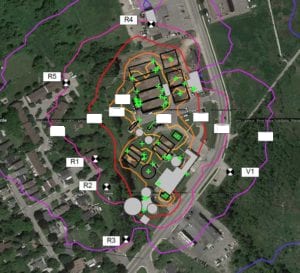Town of Orangeville Water Pollution Control Plant

Location: Orangeville, Ontario
Owner/Operator: Town of Orangeville
HGC Engineering was contracted by the Town of Orangeville to undertake an Acoustic Audit of the Orangeville Water Pollution Control Plant (“WPCP”) located at 16 Townline in Orangeville, Ontario. The Audit was required as a condition of the Environmental Compliance Approval for the facility, granted to the WPCP by the Ontario Ministry of the Environment, Conservation and Parks (“MECP”).
Description of the Facility & Surrounding Area
The facility operations runs 24 hours per day, 7 days per week. The site hosts various water processing tanks and ancillary equipment. The primary sources of noise at the facility consists of numerous water weirs, building ventilation louvres, rooftop heating, ventilation, and air-conditioning (“HVAC”) equipment, daytime visits by trucks, and daytime testing of emergency generators.
The nearest potentially impacted noise-sensitive location points surrounding the facility were identified to include single family dwellings, an apartment above a commercial building and some townhouses. Additionally, a vacant lot to the east of the site was also considered so as to address potential future impact upon currently open lands whose zoning permits the future establishment of a single dwelling.
Sound Level Criteria
The area surrounding the WPCP facility is urban in nature, and can be classified as Class 1 (Urban) area under Ontario’s MECP Publication NPC-300 . The sound level limits for a stationary source which operates during both daytime and nighttime hours in a Class 1 acoustical environment are set as the greater of the background sound level in the area or the exclusion limits of 50 dBA during daytime/evening (07:00 – 23:00) and 45 dBA during nighttime hours (23:00 – 07:00).
The daytime testing of emergency generators was also considered. As per MECP guidelines, the sound level limit for the periodic testing of emergency equipment is 5 dB greater than the limit for non-emergency operating sources of noise, and is assessed separately. The sound level limit for the testing of the emergency equipment is 55 dBA during the daytime, given that they are only tested during the daytime.
Noise Measurement Methods & Instrumentation

The sound of the facility was not clearly audible or measurable over the background sound at the identified points of reception. Therefore, the sound levels of the facility were determined using sound power emission levels measured close to each source at the facility, together with computational acoustical modelling. Sound intensity measurement techniques were employed by HGC Engineering personnel to measure the sound power all non-negligible sources at the facility. The sound power levels of all sources were used as input to a computational acoustical model. In addition to the primary noise sources identified, various sound levels from the flow of water through various tanks were measured and included in the acoustical model. The model assumed a predictable worst-case hour of operation, which includes the continuous operation of water tanks, rooftop mechanical equipment, ventilation louvres, and one truck visiting the site during daytime hours.
The results of the Acoustic Audit demonstrated that the sound levels of the facility are within the limits stipulated in the MECP Publication NPC-300.
Acoustical Engineering Services Included:
- An Acoustic Audit was done as a condition of the Environmental Compliance Approval for the facility, granted to the WPCP by the Ontario Ministry of the Environment, Conservation and Parks (“MECP”).
- Measurements of stationary sources of sound at the facility using Sound intensity instrumentation and methods
- A detailed noise source inventory
- Development of a computational acoustical model
